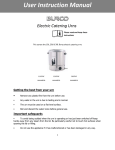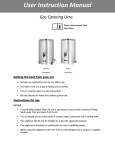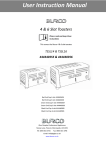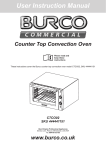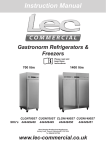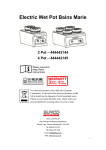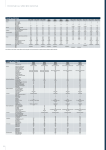Download Cooking FAQ`s
Transcript
Cooking Frequently Asked Questions _________________________________________________________ Q1.Where do I find my model and serial number? Ovens: The model number can be found on a white or silver data badge on; open the main oven door; the badge is situated on the bottom edge of the appliance or in the base of the pan storage drawer (high level models). Hobs: The model number can be found on the back or the base place of the hob. This is usually removed by the installer and stuck onto the User manual for the customer. 3| Page Q2. I have just switched on my new oven for the first time and there is a nasty smell and smoke coming from the appliance? The smell and smoke is from the protective coating of oil used during the manufacturing process. We recommend that the oven interior and furniture; shelves etc. are cleaned thoroughly with hot soapy water; wipe dry then heat the oven to maximum and leave on for 20 minutes, to ensure all oil is removed. Cooking FAQ’s Q3.My fan continues to run after I have switched my appliance off Is this normal? Yes, the appliance has a cooling fan behind the control panel of the oven. The cooling fan is to keep the control knobs cool during cooking. This will continue to run for approximately 10-15 minutes after the appliance has been switched off. Q4. What is the clearance required between the top of my hob and an extractor hood? A cooker hood should be no closer than a minimum of 650mm. If the customer has a high level grill our recommended distance is 450mm, but advise customer to check manufacturers guidelines if not a GDHA brand. Q5. How much of a gap should I leave between my freestanding appliance and kitchen cupboards? We would recommend a gap of at least 10mm on each side, to ensure ease of removal when appliance has to be pulled out for cleaning or repair. Q6. Can instruction manuals be downloaded from the website? Unfortunately at present there is no facility to do this. Q7.Why does my top door not have an inner glass? 4| Page If an appliance does not have an inner door glass in the top door, this is because the appliance is a twin cavity appliance incorporating a single oven with grill. Grill doors do not have inner door glasses. Cooking FAQ’s Q8. Why do gas appliances have to be repaired / installed by an approved engineer? Any gas appliances must be repaired / installed by a person qualified to Australian Gas Installation standard AS560. This is to ensure that the installation / repair is carried out in accordance with all current ‘gas safety regulations’. Q9. What is a multifunction oven? A multifunction is a versatile oven which has a combination of features including top heat, base heat, fanned or conventional oven options and includes a defrost facility. Q10. Can appliances be converted from Natural gas to LPG or vice-versa? Not all of our appliances can be converted – refer to Conversion Guide Page 55 for full details. Q11. I can feel hot air coming from the front of my appliance? Our gas appliances are front venting, so all the oven heat will come from the front of the appliance. Some of our Built In appliances have a power cool system, which will keep the door cool – this can also produce warm air in the front of the appliance. Q12. How do I use my programmable timer? The timers on each appliance can vary – please refer ‘Timers and Minute Minders’ section of this guide. 5| Page Q13. Can I change the hinges on my oven doors – so the door open the opposite way? We only have one ‘Built In’ Belling Appliance that the hinges can be changed -model BI60SO. The rest of our appliance hinges can NOT be changed. Cooking FAQ’s Q14. What pans should I use on my hob? GAS hob – For optimum safety and performance, we recommend the use of flat bottomed pans with a base diameter of minimum 100mm (4”) and maximum 250mm (10”). CERAMIC Hob – Stainless Steel cookware is preferred for ceramic hobs as they heat quickly, but evenly and shouldn’t streak or stain the surface. SOLID PLATE - Use pans with a flat base of minimum 100mm (4”) diameter and maximum 280mm (11”) diameter which are stable in use. Pan bases that are much smaller or much larger than the hotplate - e.g.; by 50mm will result in slower cooking times. Always ensure that pan bases are dry before placing them onto the hotplates. Induction Hob – Cast Iron pans are the perfect material with some stainless steel suitable (depending on the iron content). To check the pan, apply a magnet to the base, if it attaches the pan will work. (See information for Induction appliances on page 8) Q15. Can I use aluminium foil when cooking? No, aluminium foil should not be used to cover the grill pan or on any of the shelves in the oven as this will create a fire hazard. 6| Page Q16. Should I grill with the door open or closed? Please refer to the user manual for the specific model to ensure the correct operating procedure is followed. Q17. What is the benefit of purchasing an ‘energy efficient’ appliance? Appliances are rated for energy from A to G, A being the most efficient. Choosing an appliance with the top energy efficient rating will cut down on running costs and be kinder to the environment. Cooking FAQ’s Q18. Can I clean my oven shelves/furniture in the dishwasher? Some parts of the appliance are safe to be cleaned in the dishwasher – please refer to ‘Care & Cleaning guide’Page67. Q19. What size turkey can I fit in my oven? Advise customer on suggested sizes listed below: Oven Size (mm) Turkey Size (suggested) 500 & 550 Freestanding 12 – 14 lbs 600 Freestanding/Built In 18 lbs 720 Built In 12 – 14lbs 900 Built In 18 lbs 7| Page Q20.Why is there a gap at the top of the oven door? The gap allows airflow between the inner and outer door panels. The flow of air prevents the outer door panel from becoming too hot. Because of the gap, spillage and condensation can form inside the door, so we also provide a facility to clean between these panels. Q21.How long should I preheat my conventional oven? The ‘main oven and top oven’ should both be preheated for 15 minutes before cooking. If they are both used at the same time the cooking time may need to be shortened slightly, or the cooking temperature adjusted, to allow for heat transfer from the main oven to the top oven if both ovens are used together. Cooking FAQ’s Q22. Do I need to preheat my fanned oven? Fan ovens should be preheated for recipes that need a high temperature immediately such as puff and choux pastries, yeast mixtures, scones, whisked sponges, Yorkshire puddings and soufflés. Also, recipes needing a short cooking time(less than 10 minutes) such as biscuits, frozen and cooked chilled products may need preheating. Otherwise a cold start is recommended. Q23. What is an FSD (Flame Safety Device) A Flame Safety Device detects if the flame has gone out on the customer’s gas product and cuts off the gas supply immediately. Although this is not a requirement for commercial or residential house, all gas products being installed in multi-dwelling properties must be fitted with an FSD device. 8| Page Q24.My alarm no longer sounds? The Alarm has three tones to choose from; Press the minus button to listen to the first tone; Release the minus button and press it again to listen to the second tone etc. Releasing the minus button after the tone has sounded will automatically select that tone Q25. Why has my inner door glass shattered? The cause is usually the result of 'accidental damage' which creates a chip or scratch in the toughened glass. Customers are advised to take care when handling, using or cleaning all glass panels, as any damage to the surfaces or edges may results in the glass breaking without warning or apparent cause at a later date. In the unlikely event of a GDHA panel breaking, it does so into small fragments to minimise the risk of injury. Q25. How do Induction hobs work? Induction hobs are quicker and more controllable than gas. The hob works by using a magnetic field to heat the pan rather than through the ceramic surface of the hob. The hob is extremely efficient as it heats pans to a high temperature very quickly, but offers greater safety as only the pan is heated and the ceramic plate remains relatively cool. Q26. Are there any differences between induction cooking and regular hob cooking? As an induction hob operates slightly differently to a traditional ceramic hob, the customer may need to make some adjustments to the cooking times and temperatures to achieve the desired results. Pan contents heat more quickly with an induction hob. To reduce the cooking time, advise the customer to turn the power control to the max position and after a short time set the power control to the required position. 9| Page Q27. I have a pace maker / other medical implant. Can I still use an induction hob? The induction hob generates short-range magnetic fields. If any user or person in close proximity has a pacemaker or other active implants, advise them to consult a doctor before use, concerning any possible incompatibility to prevent any risk to health. Q28. How do I know if I can use my pans on my Induction Hob? Cast iron is the perfect material and some stainless steel, depending upon the iron content, is also suitable. To check the pan, apply a magnet to the base, if it attaches solidly the pan will work, if the magnet feels loose or does not attach the pan will not work. Also advise customer to only use flat bottomed pans. If they are unsuitable the induction hob will not detect the pan. Cooking FAQ’s Q29. How do I change the light bulb in my oven? Please see guide below – Please be aware that the light bulbs are not covered under the manufacturer’s warranty. No. of Lamps 2 (@ 25W) Bulb Location Side Oven Type All Instruction for changing the Bulb Wait until the oven is cool then remove the oven shelves. Grasp the lens cover on the light fitting and pull it away from the side of the oven. Unscrew the bulb. Replace the lens cover. 10 | P a g e 1 (@ 25W 1 (@ 25W Rear Rear Fanned/ Multifunction Conventional Wait until the oven is cool, and then remove the shelves. The oven light is at the rear of the cavity. Remove the loose oven back – unscrew the 4 securing screws (one at each corner). Unscrew the lens cover (turn anticlockwise). Unscrew the bulb and replace. Replace the lens cover and the oven back before use. Wait until the oven is cool, and then remove the oven shelves. The oven light is at the rear of the oven cavity. Unscrew the lens cover (turn anticlockwise). Unscrew the bulb and replace. Replace the lens cover. Please find common faults listed below; before arranging an engineer’s visit ensure to carry out the following checks: My oven isn’t coming on? Check the socket for power; tripped circuit or a blown fuse. Is the clock set to ‘Auto’? – If it is, you can only switch the oven on if it is set to the ‘manual mode’. See ‘Timers & Minute Minders for full details of how to set the timer. My electric oven isn’t heating Has the thermostat tripped – ask the customer to turn off the oven and wait until it has fully cooled down before trying again 11 | P a g e Is the timer set in ‘Auto’? – Refer to ‘Timers & Minute Minders’ guide for instructions how to put back to manual. The light in my oven isn’t coming on? If the appliance is switched on and the electrics have been checked the bulb may need changing. Advise the customer to consult the user manual for instructions. I have poor cooking results with my new appliance? Customers changing from a conventional oven to a modern fan assisted oven may find that they need to reduce cooking temperatures by approximately 25 degrees centigrade and cooking times by approximately 10 minutes in every hour. Make sure the customer centralises their food and uses the oven shelves (NOT the base) to enable the heat to circulate around the entire surface of the cooking vessel. Cooking Fault Finding My main oven cooking results are uneven Ask the customer to check that the cooker is level. Ensure that the oven is not overloaded, i.e. cooking on all four shelves. I have uneven cooking in my Top Oven (front to back) It important that food is centrally positioned under the grill element both when using the top oven and grilling. This is because the grill operates at a reduced power level in conjunction with an element under the floor of the oven to give top and bottom heat. Food and baking trays need to be approximately 3" from the front of the shelf. 12 | P a g e The oven fan is noisy Ask the customer to check that the oven is level (if freestanding) Check that no shelves or oven furniture are touching the back of the oven wall of the appliance I have droplets of water inside my oven? One of the main by-products of burning natural gas is the production of water vapour. Therefore steam and condensation forming between the oven door glasses is not necessarily a sign that the oven is not working correctly. Advise the customer to use a covered container, where practical to reduce the amount of condensation that forms and not to leave food in the oven to cool after it has been cooked and the oven has been switched off. Hob Fault Finding My Gas Hob won’t light? Check that the power is switched on Check the fuse in the plug and the main fuse hasn’t tripped. If lidded appliance – check that the lid is pushed back as far as possible (Lid has a valve on that will only let the gas through if fully pushed back) My Gas hob will light, but won’t stay lit? Check that the customer is keeping the control knob depressed for at least 10 seconds. 13 | P a g e The ignition on my hob burners is continually clicking when lit? Has the customer recently cleaned or spilt water on the hob top? This could cause the ignition to stick. The problem with cure itself once the hob dries out. This could also be due to grease or debris on the burner or electrodes. Advise the customer to clean with hot soapy water and ensure completely dry before switching back on. My solid hotplates are staying warm after cooking has finished? Because of the dense materials used in the manufacture of the solid hotplates they can often feel warm for a long time after the appliance has been switched off. This is a normal characteristic of solid hotplates which work in a slightly different manner to other types of electric heating elements. Hob Fault Finding My ceramic hob keeps turning itself on and off during cooking? This is a normal process to avoid overheating. Each cooking zone has a sensor which allows the zone to pulse during the cooking process. My control panel and knobs are getting hot? This is normal. The temperature of the operating panel can get as hot as 60°C above the surrounding temperature, so with a surrounding temperature of 20°C this panel can be 80°C.-Ensure the customer is using the correct size pans (see page 5) as large pans on the front rings will cause heat dispersion over the controls. 14 | P a g e I have pressed the power button but no indicators are lit. What should I do? Check that that the power is switched on (is there a power cut?) That the controls are switched on Check the fuse in the plug and the mains fuse. Is the safety lock function (key symbol) on? If your hob has this feature, consult your ‘Hob Timer & control section’ for details how to deactivate it. The power button indicator lights up, but heating does not start when power control is adjusted? Check that a pan is centrally located on the correct induction zone, and that it is suitable for the appliance. (see Q28 of Cooking FAQ’s). The induction hob will not heat up The hot plate will not glow red as it will only get hot where the pan touches it. The hot plate will not work until a pan is placed on the hob. There is a pan sensor on these products to help save on power. 15 | P a g e















